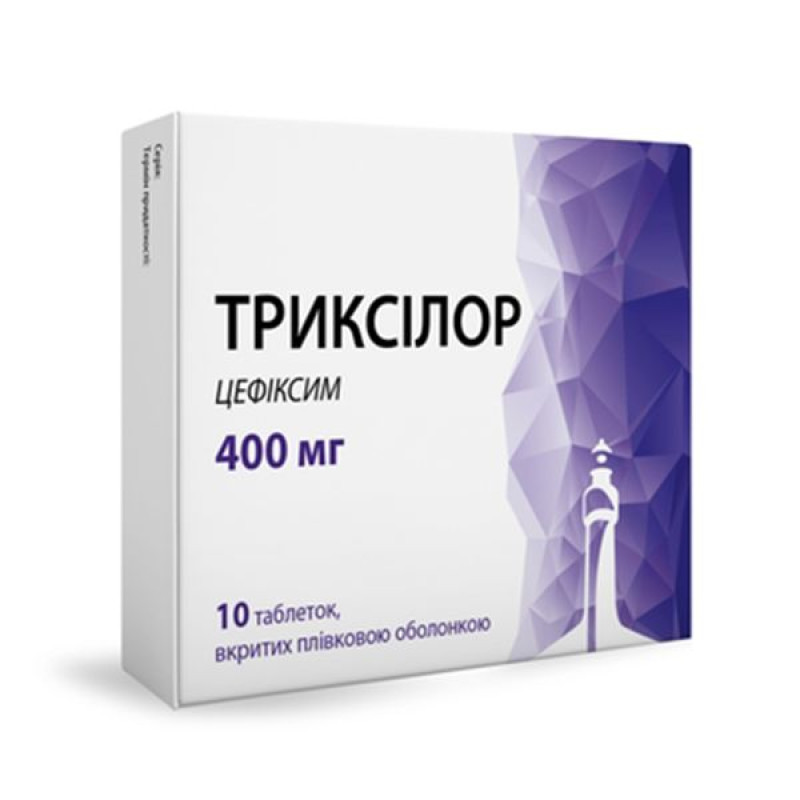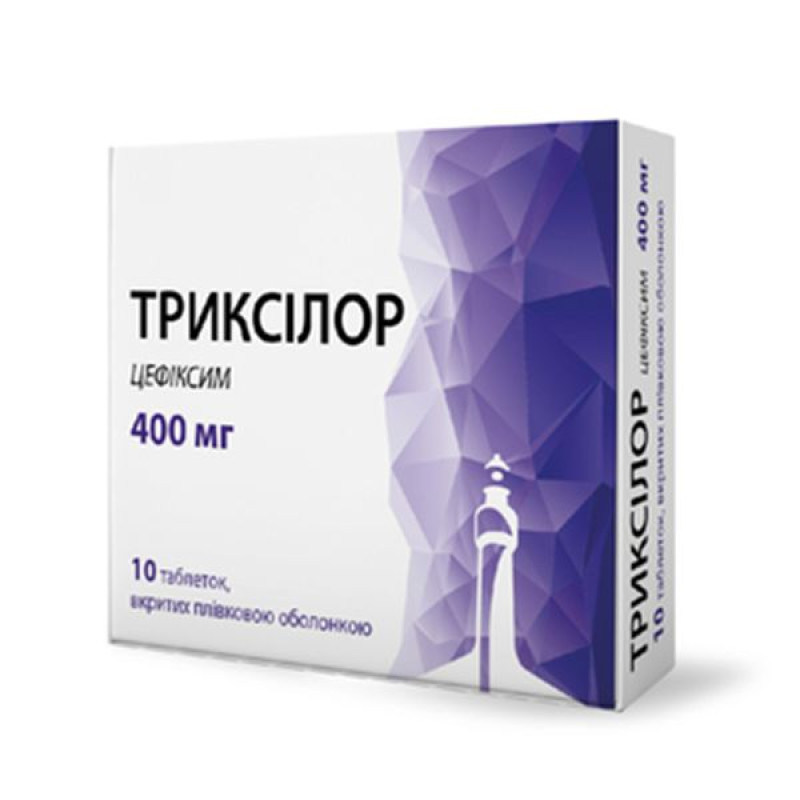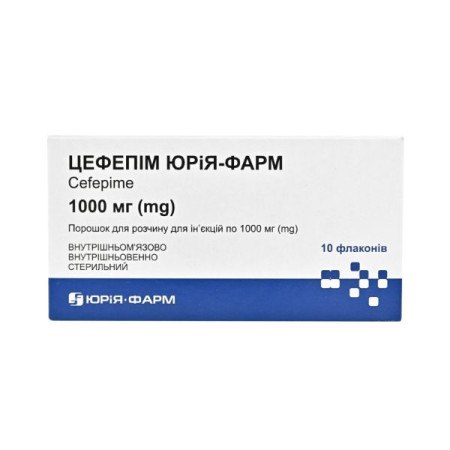Trixilor film-coated tablets 400 mg No. 10

Instructions for Trixilor film-coated tablets 400 mg No. 10
Composition
active ingredient: cefixime;
1 film-coated tablet contains 400 mg of cefixime (as cefixime trihydrate);
excipients: microcrystalline cellulose; pregelatinized starch; dibasic calcium phosphate, dihydrate, unground; dibasic calcium phosphate, dihydrate, powder; magnesium stearate;
film coating: "Opadry AMB White OY-B-28920" or equivalent amount, polyvinyl alcohol, titanium dioxide (E 171), talc, lecithin, xanthan gum.
Dosage form
Film-coated tablets.
Main physicochemical properties: oblong, film-coated tablets, white in color, with a break line on both sides and embossed with “F” on one side and “P1” on the other.
Pharmacotherapeutic group
Antibiotic of the 3rd generation cephalosporin group. ATX code J01D D08.
Pharmacological properties
Pharmacodynamics
Cefixime is a new oral cephalosporin with a broad spectrum of bactericidal activity and high resistance to the hydrolytic activity of beta-lactamases. Cefixime exerts its bactericidal action by inhibiting bacterial cell wall synthesis. It is active in vitro against a broad spectrum of clinically relevant Gram-positive and Gram-negative pathogens.
Cefixime is particularly active against the following bacteria: Streptococcus (except enterococci), Haemophilus, Branhamella, Neisseria, Escherichia, Klebsiella, Proteus, Enterobacter, Pasteurella, Providencia, Salmonella, Shigella, Citrobacter, Serratia. However, the following bacteria are mainly resistant to cefixime: Pseudomonas sp., Streptococcus sp., Listeria monocytogenes, Bacteroides fragilis and Clostridia.
Pharmacokinetics
Absorption. After a single oral dose of 200 mg, the maximum serum concentration of cefixime is 3 μg/ml, and this level is reached within 3-4 hours. After a single oral dose of 400 mg, the maximum serum concentration is higher (3.5 to 4 μg/ml), although there is no direct relationship with the dose taken. After repeated oral doses of 400 mg/day (once or twice daily) for 15 days, serum levels and bioavailability do not change, indicating that there is no accumulation of cefixime in the body. After administration of 8 mg/kg of cefixime in suspension to pediatric patients, serum concentrations are similar to those achieved in adults after administration of a 400 mg dose. Distribution. The absolute bioavailability of cefixime is approximately 50% and is not affected by food intake. In this case, the time to reach maximum concentration is delayed by approximately 1 hour. The apparent volume of distribution is 17 liters. In animals, cefixime is distributed to most tissues (except the brain) and produces tissue concentrations higher than the minimum inhibitory concentration for susceptible strains (0.20 μg/ml).
Elimination: The elimination kinetics of cefixime are characterized by a half-life of 3 to 4 hours. Cefixime is excreted unchanged by the kidneys (16–25%). Extrarenal excretion occurs mainly with bile.
No metabolites have been identified in serum or urine in humans or animals.
In elderly patients, pharmacokinetic parameters are slightly altered. A slight increase in serum concentration, bioavailability and excretion of cefixime (15 to 25%) does not require a change in the daily dose in this population. In severe renal failure (creatinine clearance
In hepatic insufficiency, excretion is slowed down (T1/2 = 6.4 hours), but the daily dose does not need to be changed.
Protein binding is approximately 70%, mainly to albumin, and is concentration-independent (at therapeutic doses).
Indication
The drug is intended for use in adults and children aged 12 years and older with a body weight of more than 50 kg for the treatment of infections caused by microorganisms sensitive to cefixime, including:
- upper respiratory tract infections (pharyngitis);
- ENT infections (otitis media, tonsillitis); lower respiratory tract infections (pneumonia, bronchitis);
- kidney and urinary tract infections.
Contraindication
Known hypersensitivity to cephalosporin antibiotics or to other components of the drug; hypersensitivity to penicillins; porphyria.
Interaction with other medicinal products and other types of interactions
Probenecid (and other tubular secretion blockers) increases the maximum concentration of cefixime in the blood, slowing down the excretion of cefixime by the kidneys, which may lead to symptoms of overdose.
Salicylic acid increases the concentration of free cefixime by 50% due to displacement of cefixime from protein binding sites; this effect is concentration-dependent.
Carbamazepine may cause an increase in cefixime plasma concentrations, therefore it is advisable to monitor its plasma levels.
Nifedipine, a calcium channel blocker, can increase the bioavailability of cefixime by up to 70%.
Other forms of interactions: the use of cephalosporins may cause a false-positive reaction when determining glucose in the urine using Benedict's, Fehling's solutions or when using "Clinitest" tablets. During the use of cefixime, the direct Coombs test may give a false-positive result.
Application features
Encephalopathy: Beta-lactam antibiotics, including cefixime, increase the risk of encephalopathy (which may manifest as seizures, confusion and impaired consciousness, and movement disorders), especially in cases of overdose or in patients with impaired renal function.
Severe skin reactions: Serious skin reactions, such as toxic epidermal necrolysis, Stevens-Johnson syndrome, and drug reaction with eosinophilia and systemic symptoms (DRESS), have been reported in some patients treated with cefixime. Cefixime should be discontinued if serious skin reactions occur and appropriate treatment and/or precautions should be taken.
Hypersensitivity Reactions: Before using cefixime, careful inquiry should be made regarding the patient's history of hypersensitivity reactions to penicillins and cephalosporins or to other drugs.
Cefixime should be used with caution in patients with a history of allergic reactions to penicillins. There has been evidence of cross-allergic reactions between penicillins and cephalosporins in both in vivo (in humans) and in vitro studies. Although such cases have been reported rarely, the reactions have been of the anaphylactic type, particularly after parenteral administration.
Antibiotics should be used with caution in patients with a history of any form of hypersensitivity reactions, especially after the use of drugs. In the event of an allergic reaction, the use of the drug should be discontinued immediately.
Antimicrobial resistance. Treatment with cefixime increases the risk of bacterial resistance, with or without overt clinical superinfection. Superinfection. Prolonged use of antibiotics may occasionally result in overgrowth of non-susceptible organisms. If superinfection occurs, appropriate therapy should be instituted.
Anemia: Cases of hemolytic anemia, including severe cases with fatal outcome, have been reported following the use of cephalosporins. Recurrent cases of hemolytic anemia following the use of cephalosporins have also been reported in patients who previously experienced hemolytic anemia following initial administration of cephalosporins, including cefixime.
Acute renal failure: As with other cephalosporins, cefixime may cause acute renal failure, particularly tubulointerstitial nephritis as the underlying pathological condition. If acute renal failure occurs, cefixime should be discontinued and appropriate therapy and/or measures should be initiated.
Renal impairment: For patients with severe renal impairment and for patients undergoing haemodialysis or peritoneal dialysis, the dose of cefixime should be reduced accordingly (see section 4.2).
Changes in intestinal microflora. Prolonged use of antibacterial drugs may cause the growth of non-susceptible microorganisms and disruption of the normal intestinal microflora, which may lead to excessive reproduction of Clostridium difficile and the development of pseudomembranous colitis. In mild forms of pseudomembranous colitis caused by the use of antibiotics, discontinuation of the drug may be sufficient. If the symptoms of colitis do not improve after this, oral vancomycin, which is the antibiotic of choice in the event of pseudomembranous colitis, should be prescribed.
In case of moderate or severe colitis, electrolytes and protein solutions should be added to the treatment. Concomitant use of drugs that reduce intestinal peristalsis should be avoided. Broad-spectrum antibiotics should be prescribed with caution to patients with a history of gastrointestinal diseases, especially colitis.
Laboratory data: Reversible changes in liver, kidney and blood function tests (thrombocytopenia, leukopenia and eosinophilia) may occur with cefixime.
Cephalosporins increase the toxicity of alcohol, so it is not recommended to drink alcoholic beverages during treatment with cefixime.
Use during pregnancy or breastfeeding
The use of the drug during pregnancy and breastfeeding should be considered only if the expected benefit to the mother outweighs the risk to the fetus or child.
Pregnancy: No embryotoxic effects of cefixime have been identified. The drug should be avoided during the first three months of pregnancy.
Breastfeeding: There is no data on the penetration of cefixime into breast milk.
Ability to influence reaction speed when driving vehicles or other mechanisms
The use of cefixime does not affect the speed of reaction when driving or operating other mechanisms. In case of dizziness, driving or operating other mechanisms should be avoided.
Method of administration and doses
The score line on both sides of the tablet is not intended to divide into equal doses.
The daily dose for adults and children over 12 years of age with a body weight of more than 50 kg is 400 mg once.
The duration of treatment depends on the nature of the disease and the type of infection. After the disappearance of symptoms of infection and/or fever, it is advisable to continue taking the drug for at least 48-72 hours.
To prevent complications, cefixime should usually be taken for 5–10 days for upper respiratory tract or urinary tract infections, and for 10–14 days for lower respiratory tract infections.
Treatment for otitis media usually lasts 10–14 days.
In infections caused by group A beta-hemolytic streptococcus, to prevent the occurrence of late complications (acute articular rheumatism, glomerulonephritis), treatment should last at least 10 days.
For uncomplicated lower urinary tract infections in women, the drug can be used for 1–3 days.
The drug should be administered with caution to patients with renal insufficiency; with creatinine clearance ≤ 20 ml/min, the daily dose of the drug should be reduced to 200 mg. There are no age-related dosage recommendations for elderly patients.
Children. The drug is used in children aged 12 years and older with a body weight of more than 50 kg.
Overdose
When using beta-lactam antibiotics, in particular cefixime, there is a risk of encephalopathy, especially in case of overdose or in patients with impaired renal function.
No cases of drug overdose were observed. Adverse reactions observed when using the drug in doses up to 2 g in healthy study participants did not differ from adverse reactions observed in patients who took the drug in recommended doses.
Symptoms: increased manifestation of adverse reactions.
Treatment: Gastric lavage, symptomatic and supportive therapy. There is no specific antidote. Hemodialysis or peritoneal dialysis only slightly contribute to the removal of cefixime from the body.
Adverse reactions
The following are adverse reactions observed during clinical trials and in the post-marketing period.
| Blood and lymphatic system disorders | Eosinophilia, hypereosinophilia, agranulocytosis, leukopenia, neutropenia, granulocytopenia, hemolytic anemia, thrombocytopenia, thrombocytosis. |
| Gastrointestinal tract | Stomach cramps, abdominal pain, diarrhea*, dyspepsia, nausea, vomiting, flatulence, dysbacteriosis, candidiasis of the oral mucosa, stomatitis, glossitis. |
| Liver and biliary tract | Jaundice, hepatitis, cholestasis. |
| Infections and infestations | Pseudomembranous colitis, vaginitis. |
| Laboratory indicators | Increased aspartate aminotransferase, increased alanine aminotransferase, increased blood bilirubin, increased blood urea, increased blood creatinine. |
| From the nervous system | Dizziness, headache. Convulsions have been reported with cephalosporins, including cefixime (frequency not known)**. Beta-lactams, including cefixime, predispose patients to encephalopathy (which may include convulsions, confusion, impaired consciousness, movement disorders), particularly in cases of overdose or renal impairment (frequency not known)**. |
| Respiratory, thoracic and mediastinal disorders | Dyspnea |
| Renal and urinary disorders | Acute renal failure with tubulointerstitial nephritis (see section "Special warnings and precautions for use"). |
| On the part of the immune system | Anaphylactic reaction, angioedema, serum sickness-like reaction. |
| Skin and subcutaneous tissue disorders | Drug reaction with eosinophilia and systemic symptoms (DRESS syndrome), erythema multiforme, Stevens-Johnson syndrome, toxic epidermal necrolysis, urticaria, rash, pruritus, genital pruritus, acute generalized exanthematous pustulosis (see section "Special warnings and precautions for use"). |
| General disorders and administration site conditions | Drug fever, arthralgia, fever, facial edema, anorexia, candidal vaginitis. |
* Diarrhea is more commonly associated with high doses of cefixime. Some cases of moderate to severe diarrhea have been reported; sometimes requiring discontinuation of therapy. Cefixime should be discontinued if severe diarrhea occurs.
** Cannot be estimated based on available data.
Reporting of suspected adverse reactions. Reporting of adverse reactions after registration of a medicinal product is of great importance. This allows monitoring of the benefit/risk ratio when using this medicinal product. Medical and pharmaceutical professionals, as well as patients or their legal representatives, should report all cases of suspected adverse reactions and lack of efficacy of a medicinal product via the Automated Information System for Pharmacovigilance at the link: https://aisf.dec.gov.ua
Expiration date
2 years.
Storage conditions
Store in original packaging at a temperature not exceeding 25 ° C. Keep out of the reach of children.
Packaging
5 tablets in a blister; 1 or 2 blisters in a cardboard box.
Vacation category
According to the recipe.
Producer
ACS DOBFAR S.P.A.
Location of the manufacturer and address of its place of business
V. LAURENTINA KM 24,730, POMEZIA (RM), 00071, Italy
There are no reviews for this product.
There are no reviews for this product, be the first to leave your review.
No questions about this product, be the first and ask your question.




